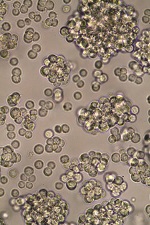Valneva has already made 5 deals this year for vaccine makers to use its EB66 cell line, which is derived from duck embryonic stem cells, allowing for faster vaccine manufacturing. Now, it is adding two more deals to the list.
 |
| EB66 cells--Courtesy of Valneva |
The first license was granted to Italy-based Fatro for the development of two veterinary vaccines using EB66, and the other was granted to Kaketsuken to develop a novel human vaccine candidate with EB66 cells.
This isn't the first time Kaketsuken has used Valneva's cell line. In 2014, Japanese health authorities gave the company a marketing nod for its H5N1 pandemic flu vaccine made with EB66. And in March this year, they approved an EB66-based vaccine prototype against any strain of pandemic flu.
Valneva anticipates that the Japanese government will award Kaketsuken a stockpiling contract this year, leading to the first royalties for an EB66-based human vaccine in 2016, the company said in a statement. This would be a boost for Valneva, which has a number of vaccines in development, but only markets vaccines for Japanese encephalitis and now, cholera with its Dukoral, acquired from Johnson & Johnson ($JNJ) this year for €45 million ($50 million).
"The EB66 cell line has proven its performance in the development of both veterinary and human vaccines with the marketing approval of three new EB66-based vaccines in 2014 in three different regions of the world at a time when the regulatory environment is very demanding," said Thomas Lingelbach, president and CEO of Valneva, and Franck Grimaud, deputy CEO, in the statement. "The industry is becoming increasingly aware that the half-century-old egg-based method of producing vaccines has major limitations and some of the world's largest pharmaceutical companies have already found in Valneva's EB66 technology an excellent replacement for egg-based vaccine production."
Flu vaccines have traditionally been produced using a 6-month, egg-based process. The time taken to manufacture them forces companies to formulate flu vaccines far in advance of when they will be used, which can result in a mismatch between the vaccine strains and the actual circulating strains. Protein Sciences and Novartis ($NVS)--which has now sold its flu vaccines business to CSL--both market cell-culture vaccines that take just weeks to produce. And there is a host of other companies working on alternatives to egg-based flu shots. Novavax ($NVAX) and VaxInnate have both taken their recombinant quadrivalent flu jabs into Phase III.
- read the release